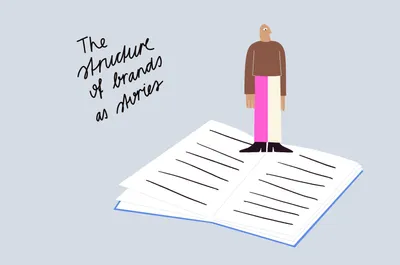
Why brands are stories? Part II. The structure of brands as stories
In a series of three articles, Marc Català, partner at Mucho, explores the intimate links between brands and stories.
Values in order: a narrative structure
The importance of values for a brand is agreed upon by most branding experts. But stating a set of generic values in no given order doesn’t give you a story. At best it gives you an ethical standpoint, but it is still a set of abstract ideas which are hard to relate to and remember.
Now when you give them a meaningful order, everything changes. That meaningful order follows the structure of stories, and there is science to support that this structure is related to the biological structure of our brain. Yes, we are hardwired as a story ourselves.
It is the ending what of the story what the brand has to offer to the world, also called the value proposition in branding.
Intro: In the beginning there was chaos
This is how all stories start. With a fault, a void, a problem, a conflict or the biggest hurdles of them all: chaos itself. In branding, this is related to a brand’s purpose, a brand’s why or reason to be. This purpose is always to solve the lack of an essential thing we value. That essential value is what we as a brand exist for. And here that little red button called emotion goes click.
For us humans, the emotions of pain, loss, happiness or what have you, are unsurprisingly close to an original void. A little something we are missing. The void we feel is the energy that fuels our innermost desires. A brand story says what you’re passionate about doing. It says what you’re fighting against to make tomorrow better. It says why you’re special. It tells people what the world is missing and how you’ll fix it for them.
Stating a set of generic values in no given order doesn’t give you a story, you have to give them a meaningful order.
The middle: Next comes the adventure, a way of doing things
Now the next set of values is about the things we value to obtain or pursue that original purpose. These are about rational and differential ways in which we toil to succeed. Brands convey this as their unique approach to producing value, in ways other companies, –namely the competition– are not as good at. As consumers, when we value a certain way of doing, we will also value the brand or product that operates in that way. When brands explain themselves in such a way, they are telling a story which defines them. A brand talking about the value of security is quite different from one proclaiming the power of creativity.

The end: And the grand finale, what value do we offer
The constant pursuit of a certain initial value produces in its turn a final output value. This is what the brand has to offer to the world. It is the ending what of the story, or sometimes called in branding, the value proposition. It is the tangible value that we on the receiving end will get. It is always connected to the initial reason.
It is the end that answers the initial question. In branding, it is the end of the story.
Many brands mistake the subtle art of seducing, because they try to start the story at the end. But as we know, this doesn’t work. We are missing out on the whole unfolding of the value story by doing this. Most importantly, we will never be seduced by the conclusive what that we are offered. Instead, it is in the initial reason for being that we find the appeal. It is because there is an initial problem to solve, a conflict to resolve or a void to fill, that the final solution makes sense.
Once values are unveiled through the structure of a story, they make more sense. All of a sudden, they become more memorable. Also, they become more ownable.
Making values ownable through stories
Now that values are organized in such a meaningful way, is it not obvious how much more powerful they become? Once values are unveiled through the structure of a story, they make more sense. All of a sudden, they become more memorable. Also, they become more ownable.
Brands that turn their values into compelling narratives attach themselves to those values.
By telling their story they make the values clearer, more definable, more tangible. Crucially they make values more distinct. And so we link the story to the storyteller. Because it is their story. And if we believe it, so too it becomes ours.
Stay tuned for the third part of this series, and find out how values can be structured into a story to obtain a meaningful brand.
Words: Marc Català, partner at Mucho
Illustrations: @lenka.re


